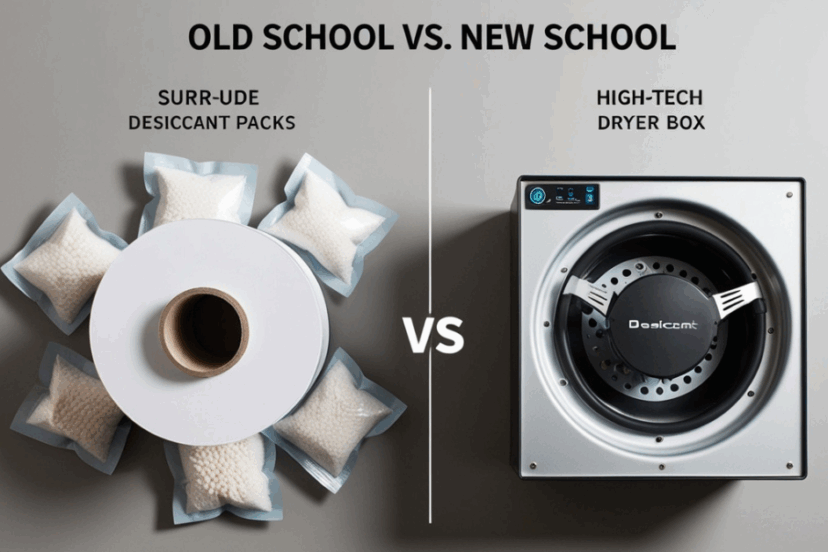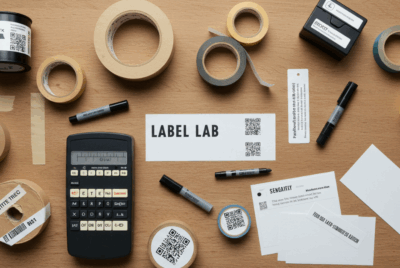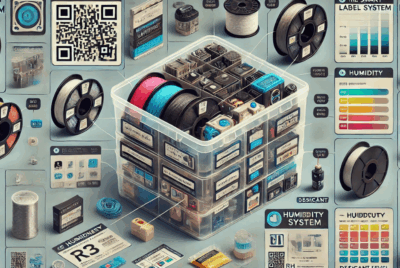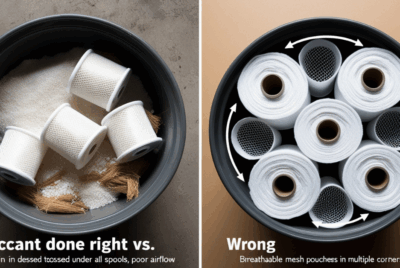Desiccant Packs vs. Electronic Drying Boxes: Which Is Better for Filament Storage?
1. The Battle for Dry Filament
Dry filament = happy prints.
So what’s the best way to keep moisture away—good old desiccant packs or an electronic drying box?
This debate isn’t just about tools—it’s about convenience, budget, space, and how often you print. Let’s break it down and help you decide what’s best for your setup.
2. Why Moisture Matters More Than You Think
Moisture turns your perfectly spooled filament into a printing disaster. You’ll see:
- Steam pops and bubbling
- Inconsistent layers
- Stringy prints
- Poor adhesion and weak parts
And once it’s soaked up moisture, only drying can save it.
3. How Do Desiccant Packs Work?
Desiccant packs are tiny moisture-absorbing pouches, typically filled with silica gel or calcium chloride. They draw humidity out of the air in sealed containers, keeping your filament drier for longer.
They’re cheap, passive, and super easy to use.
4. What Are Electronic Filament Dryers?
Electronic filament dryers use low, consistent heat to bake moisture out of the filament. Some models also maintain humidity control while you print directly from the box.
They’re active, reusable, and give more control over drying time and temperature.
5. Key Differences at a Glance
| Feature | Desiccant Packs | Electronic Dryers |
|---|---|---|
| Cost | Low ($5–$15 per set) | Higher ($50–$150) |
| Reusability | Limited (can be recharged) | High |
| Drying Speed | Slow (24–72 hrs) | Fast (4–8 hrs) |
| Control | None | Adjustable temp/timer |
| Print-While-Dry? | ❌ No | ✅ Yes |
| Best For | Long-term storage | Active drying & frequent use |
6. When Desiccant Packs Are Good Enough
Use desiccants if:
- You print occasionally
- You store your filament in airtight bins or bags
- You live in a dry climate
- You want a low-cost moisture defense
💡 Pro Tip: Use color-changing silica gel so you know when to recharge.
7. When a Filament Dryer Is the Better Choice
Use a dryer if:
- You print several times per week
- You live in a humid or coastal region
- You use moisture-sensitive filaments (like Nylon, PETG, or TPU)
- You want precise drying times and temps
- You need to dry filament quickly before printing
8. Cost Comparison: Which Saves More Over Time?
Desiccants are cheaper upfront—but they can become ineffective fast in humid environments.
A one-time purchase of a $60 dryer like the SUNLU S2 can last for years and revive dozens of spools, saving you from print failures and wasted filament.
9. Space and Setup Considerations
| Setup Needs | Desiccants | Electronic Dryer |
|---|---|---|
| Space | Very small (fits in bags) | Medium (needs counter space) |
| Power | None | Requires outlet |
| Portability | ✅ Extremely portable | ⚠️ Less portable |
For compact workspaces or mobile setups, desiccants win for space-saving.
10. Can You Combine Both for Better Results?
Yes! That’s the ideal strategy.
- Use a dryer to revive wet filament
- Then store it with desiccant packs in a sealed container
- For active printing, print directly from a dryer box
Combining both gives you the best of both worlds: prevention and restoration.
11. Popular Types of Desiccants Used in 3D Printing
- Silica Gel: Color-changing beads that can be baked to recharge
- Calcium Chloride: Absorbs more moisture but not reusable
- Molecular Sieves: More powerful but more expensive
- Rechargeable Units: Plug-in boxes that recharge built-in desiccants
Stick with silica gel for ease and cost-effectiveness.
12. Top-Rated Electronic Filament Dryers in 2024
| Dryer | Best For | Key Features |
|---|---|---|
| SUNLU S2 | Everyday users | Compact, fast, affordable |
| PrintDry Pro | Multi-spool or Nylon users | Holds 2 spools, adjustable temps |
| eSUN eBox | Entry-level | Basic heat and humidity control |
| Polymaker PolyDryer | Professionals | Durable, precise, sleek |
Each has its strengths—pick based on frequency and filament type.
13. Real-World Use Cases: Who Should Use What?
👩🎨 Weekend Hobbyist (PLA/ABS only)
- ✅ Use desiccants
- 🟡 Dryer optional
🔧 Frequent Maker (PETG/TPU/PETG)
- ✅ Use a dryer
- 🟡 Add desiccants for backup storage
🧪 Prototyper (variety of filaments)
- ✅ Dryer + sealed bins
- ✅ Use both to maximize uptime
14. Storing in Humid Climates: Which Wins?
In high-humidity zones, desiccants wear out quickly. You’ll find yourself replacing or recharging them often.
That’s where a filament dryer is worth every cent—especially if you’re using materials like Nylon or PVA.
15. Final Thoughts: Match Your Tools to Your Printing Style
So, desiccant vs filament dryer—what’s the winner?
That depends on your:
- Climate
- Printing frequency
- Filament types
- Budget and workspace
✅ Casual printer in a dry area? Go with desiccants.
✅ Frequent printer or humid location? A dryer is your best friend.
✅ Serious about quality? Use both—and never look back.
❓FAQs
- How often do I need to replace desiccant packs?
When they change color or after ~1 month of use in high humidity. You can recharge silica gel in the oven. - Can a filament dryer over-dry filament?
Not usually, but follow the recommended temps for each material to avoid softening or damage. - Do desiccants work if the container isn’t sealed?
Not well. Desiccants are only effective in airtight environments. - Is it okay to leave filament in the dryer box for days?
Yes, as long as the temp stays in the safe zone (typically below 60°C). - What’s the best setup overall?
Dry filament in a dryer, then store it in vacuum-sealed bags or bins with desiccant.




